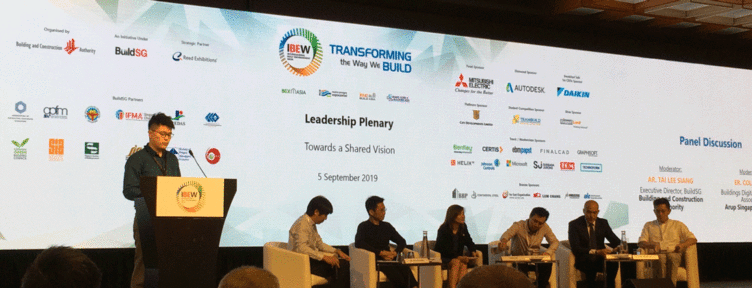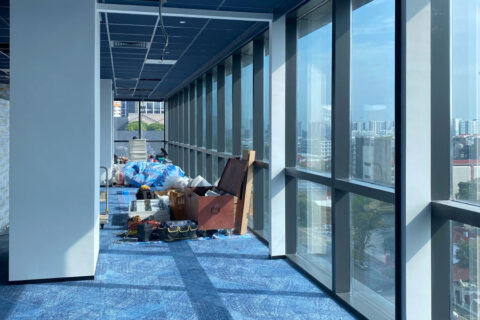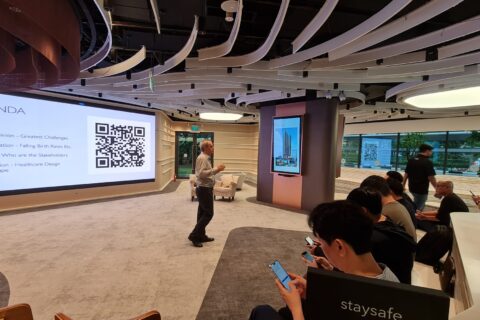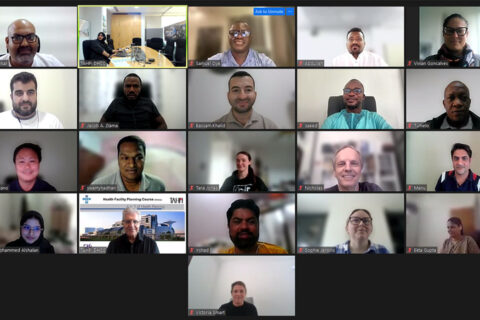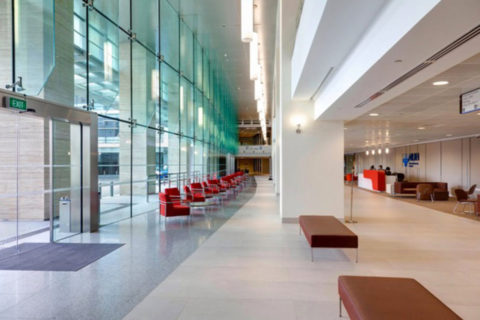Last week I had the opportunity to participate in the IBEW Conference at Sands Expo, Singapore, where we discussed the future of our cities. Tai Lee Siang, Executive Director at the Building Construction Authority, and a considerable team of organisers, speakers, sponsors and exhibitors did a great job persuading delegates to consider our future experience with the planet. This was portrayed through something close to the heart of our Nation; our property, our buildings and our city.
The Future City – Bring it On!
There were so many touch points and great presentations but what really strikes home, is the realisation that we are all in this together. The Future City is for our nation to create, we can lead the way because we are in the goldilocks belt. Conditions are perfect for the industry to adopt new models to solve change and adaptability in a city. Bring it on!
I didn’t manage to catch every session but here are some takeaways.
Healthy Interiors are Good
Healthy interiors are really good for business because the cost of human capital is so high! A 1% reduction in sick leave or a 1% increase in productivity is equal to a 9% saving of the operational cost of the occupied building. Compare this to the utility costs of 1%, and you can see we should not be squeezing everything from the running cost. Organisations who want to get the most from their real estate assets, shouldn’t need much persuasion to engage a specialist for interior planning and design services. Thanks to Scott Dunn of AECOM for the insight.
Esther An of City Developments Limited expanded on the healthy interiors theme stating ESG is right at the top of developer’s concerns. To create a healthy and sustainable building, developers need to invest at the on-set, before design. Green Bonds and Green Loans are available to assist with the cost of renovating or modernising older buildings. This in turn will enable occupiers to continually benefit from the increasing speed of technology development and innovation.
City populations are set to double by 2050 with global construction forecast to grow 80% by 2030. The only way we are going to meet the build challenge is to embrace technology to fix our fragmented supply chain and other systemic issues. The presenter, Brian Shuptrine of Turner and Townsend spoke about buildings having a digital twin. He drew our attention to emerging delivery models such as partnerships or models like WeWork, where the operator is owner, developer and designer. Brian advocates a design strategy that keeps the full life of an asset in mind.
The Future of Our Cities is Bright
Dr. Chris Luebkeman of Arup set the scene for the second day, speaking about man’s intervention and the “unintended consequences” of our progress and our work. He suggested that we are the first generation to see and know of the impact we are having. The wonderful presentation continued with a call to action, “If you could remove repetitive tasks in your practice, why wouldn’t you do that? If we could be aware of how things are working, if we could predict performance in our cities, why wouldn’t we do that? If we could fabricate anything, why wouldn’t we do that?” All accompanied by thought provoking illustrations of course. Dr. Luebkeman concluded by stating that for the benefit of future generations, we mustn’t hide from our duty of care.
Echoing key points of the first day, Nicolas Mangon of Autodesk opened with the statement that globally, “we will double the size of our cities in 30 years”, and we will have to do it with less resources. He presented great examples of machine learning and spoke of how Autodesk are developing the tools to enable the ‘future of making’. An eye-opening segment was demonstrating the power of computer vision, collecting real-time data as people move through a space. The technology allows operators to analyse the use of the space and intervene to improve user experiences.
Dr. Ayesha Khanna of ADDO AI, recommended that we keep things ‘customer centric.’ This requires us to look at behaviour in a new way and focus on understanding the problems people face rather than the old way of analysing an event. Her recommendations are centred on design thinking; “look for and identify challenges and pain points, then work with the data guys to explore solutions.” Great presentation.
All this is suggesting the future of our cities is bright, but we need to move much faster. To do that we need new ownership models and creative models of developing real estate. We can ponder why we express a desire to own a piece of real estate in the city and lock-up a building block that we can reimagine and engineer into something new and more purposeful. On the contrary, a common thread with developers was recognising the influence responsible ownership brings to the industry. Perhaps the same is not true in other nations. Someone did point out in their presentation, that at the beginning of the last century over 90% of the world’s population rented their homes. If we were to invest in property companies and return to the previous model of renting the spaces in our cities, transformation could come about a whole lot faster.
What The Customer Needs
Sylvia Koh-Gratton of CapitaLand Commercial Management Pte Ltd and Cheng Hsing Yao of Guocoland (Singapore) Pte Ltd elaborated on the needs and desire of the customer. Technology is a wonderful tool in helping us meet the customers needs; “if only the systems could talk to each other!” lamented Sylvia. The presenters spoke of integrated mixed development such as Guoco Tower as being suitable models for high density environments. These developments integrate transportation allowing people to move quite freely without meeting roads or traffic. The scale provides the opportunity to incorporate public spaces and urban parks that city dwellers and visitors can use. Esther An shared some of the processes her team employ to bring successful projects to market. They begin by asking potential occupiers what sort of hardware and software they need. There’s a constant feedback loop through co-creation opportunities with landlords and tenants. Output is then brought back to the lab and applied. Through this process, they see a consistency in what tenants want;
- Co-working and Flexibility – amenities, white spaces for low use facilities which can be shared, such as training rooms.
- Customer Service – a customer centric mindset, support for long working hours and grass roots events.
- Technology Enabled – building where technology works seamlessly at the lowest possible cost, reducing utility bills, etc., data informed.
- Green Technologies – landlord tenant partnerships.
The session was brought to a close by Chris Bicknell of Aecom demonstrating that a change in mindset is necessary to meet customer expectations. We need to fulfill the pressing needs to increase the quality of our buildings and cities to meet the anticipated population explosion. In a nutshell, we need to design and build faster (toolkits), smarter (libraries) and better (convergence). We need to think of design in a much wider sense; aesthetics, maintainability, experience and whole life cycle cost.
Think Big, Think Data
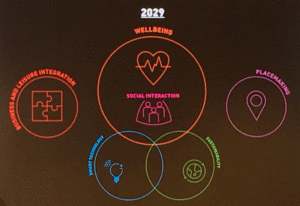
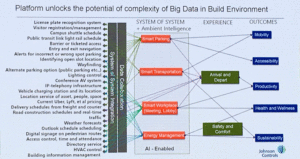
AI is critical to transforming the built environment and the workplace on the scale we are discussing. “It has the capability to sense, learn, predict, control and optimise,” he states. So where do we look for these challenges and pain points? In the user experience, as this drives behaviour and the particular outcomes we are designing for.
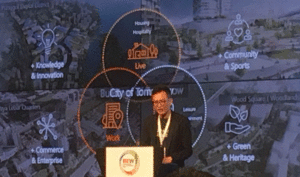
We Need a Revolution
This led to a great panel discussion with statements such as, “we need a revolution,” and “architects should be paid for good ideas,” from Ron Bakker. He further commented that the buildings we build today are mostly empty. Another statement by Seah Chee Huang was to “make rural landscapes and setting more viable.” Alvin Ng expressed that harnessing data will enable us to change the future baseline as we learn more about people, space, assets and time. Uncertainty in the way people will live and work in the future was a theme. This makes it very difficult for us to describe the types of spaces we may need in our future cities. There would be less need for single use land plots for instance. This led to Seah Chee Huang to suggest that one of the greatest challenges we face is what to do with the existing stock of buildings.
Leaders Unite to Change
The Leadership Plenary ended the day. On the stage was an architect, a developer, a master builder and an engineer. They were Wong Mun Summ of WOHA Architects Pte Ltd, Cindy Lim of Keppel Urban Solutions, Neil Yong of Woh Hup (Private) Ltd and Lee Ang Seng of Beca Carter Hollings & Ferner (SE Asia) Pte Ltd. The moderator was Tai Lee Siang.
All agree that change is absolutely necessary and inevitable but the question still remains, how? If the future of our cities is going to be bright, we can no longer remain in silos. We need to move away from linear processes, we need to collaborate for the benefit of the user, the people, the global community. Asked what is the catalyst for change, Neil Yong suggested that organisational innovation must drive the systemic change.
So we know to succeed, we need to see our organization as an integral part of the solution. Innovate within to facilitate change. We also need to talk to each in a more liberal way and move forwards as an industry. This includes the interior design industry.
Provide a Secure Environment
So I came away wondering how much knowledge there is in the industry, particularly residing with architects, engineers and designers? Do we bury that knowledge with each project?” Not that best practice and lessons learnt are not carried over, but what if a great idea is lost in the process of building? Perhaps the execution was poor or the technology to make it, to see it through, was not available. Perhaps there wasn’t the time to explore. As designers, we need a secure environment to experiment, to explore new ideas in a hands-on way.
MERROWSMITH DESIGN PARTNERSHIP is a Singapore based consultancy experienced at creating spaces which increase the value of businesses and assets. Our goal is to advance healthcare through design innovation, shaping the fabric that supports strategic initiatives to improve patient outcomes. MERROWSMITH DESIGN PARTNERSHIP helps businesses optimise their space, eliminating inefficiencies and inspiring teams to deliver really outstanding work.
https://merrowsmith.com/about-us/

